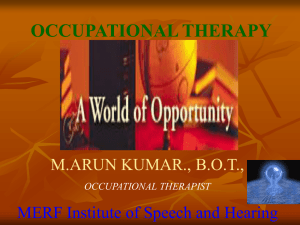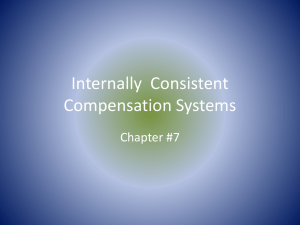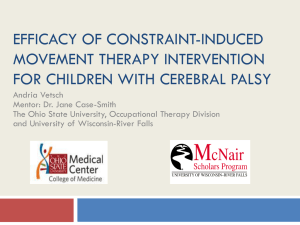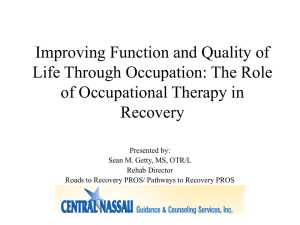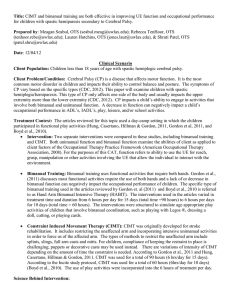The use of meaningful activity in neurological
advertisement
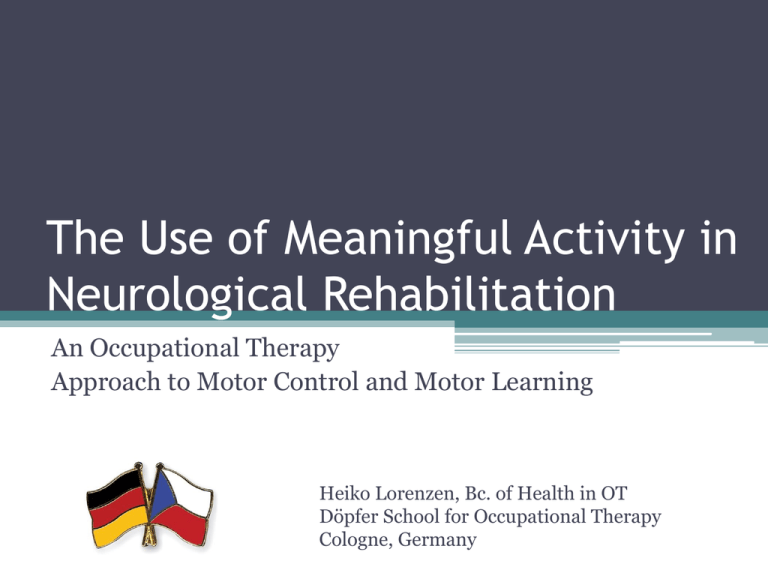
The Use of Meaningful Activity in Neurological Rehabilitation An Occupational Therapy Approach to Motor Control and Motor Learning Heiko Lorenzen, Bc. of Health in OT Döpfer School for Occupational Therapy Cologne, Germany 2 Overview • • • • • Introduction to Occupational Therapy Introduction to CIMT Application of CIMT in Occupational Therapy Case Example „Musician“ Discussion 3 Basic Assumptions in Occupational Therapy • „Occupation“ refers to all meaningful activities that make up an individual life • The engagement in occupations is associated with participation, health, well-being and quality of life • Occupational therapists aim to engage their patients in activities that are meaningful to them in order to facilitate participation 4 Occupational Therapy in Motor Control and Motor Learning • Motor control is the ability to fixate the body and to move the body (Gilmore & Spaulding 2001) • Motor learning refers to changes in movement behavior as a result of practice or experience (Gilmore & Spaulding 2001) • Occupational therapists make use of three different interventions in motor learning (AOTA 2008): ▫ Preparatory methods ▫ Use of purposeful (therapeutic) activities ▫ Engagement in desired occupations 5 Introduction to the Constraint Induced Movement Therapy (CIMT) • CIMT is based on the learned disuse after the onset of neurological disorder 6 Development of learned disuse (figure adapted from: brainworksrehab.com) Injury / Stroke Unsuccessful motor attempts Positively reinforced Feelings of failure Compensatory behavior Behavior suppressed Less effective behavior strengthened Learned disuse of limb 7 Introduction to CIMT • The downward spiral of disuse leads to greater disability of the affected arm and hand (Wolf et al 2006) • Use it or lose it! • Affected limb needs to be „forced“ into activity • Typical CIMT program: 3 hours/day of therapy, 5 days/week for 4 weeks + 5 – 6 hours at home (Earley et al 2010) 8 Introduction to CIMT • Criteria for application of the CIMT method (Wolf et al 2006): ▫ ▫ ▫ ▫ ▫ ▫ ▫ ▫ ▫ ▫ ≥6 months post-stroke No or mild cognitive impairments (MMSE ≥24) Ambulatory without the use of assistive devices ≥45° shoulder flexion and abduction 45° external rotation at the shoulder Full elbow extension 45° forearm supination and pronation ≥ 5° wrist extension 5° digital exension (specifically thumb, index + middle finger) Ability to grasp and release a washcloth 3 times within 1 min. 9 Application of CIMT in Occupational Therapy • Application of preparatory methods ▫ ▫ ▫ ▫ stretching of the affected upper extremity joint mobilization training the strength of the hand taktile stimulation 10 Application of CIMT in Occupational Therapy • Use of purposeful (therapeutic) activities ▫ ▫ ▫ ▫ practicing to unscrew a bottle of water practicing to use cutlery practicing to grasp and move a table tennis racket practicing the typical movements for playing a certain musical instrument ▫ practicing to use a jig saw 11 Application of CIMT in Occupational Therapy The chosen preparatory methods and purposeful activities need to match the demands of the desired occupation! 12 Application of CIMT in Occupational Therapy • Performance of meaningful activities (ideally within the own context) ▫ ▫ ▫ ▫ using cutlery at home or in a restaurant playing table tennis with a friend or in a club playing the musical instrument doing craftswork at home or at work 13 Case Example „Musician“ from Earley et al (2010) • 52 year old woman, 4 years after lefthemispheric stroke • Decreased gait functions • Decreased strength and decreased use of the affected right upper extremity • Difficultuies in performing several basic ADL´s 14 Case Example „Musician“ • Preparatory methods ▫ Manual stretching of anatomic structures ▫ Progressive resistive exercises ▫ Weight bearing and joint compression • Performance of purposeful activities ▫ Simulation of violin playing ▫ Engagement in cooking activities ▫ Arranging a photo album 15 Case Example „Musician“ • Engagement in a variety of meaningful activities at home during 5 – 6 hours daily • After functional improvements and increased self-confidence this included also practicing to play her violin 16 Case Example „Musician“ • Some of the results: ▫ 50% increase of grip strength and pinch strengh ▫ Improvement of fine motor hand use measured with the Nine-Hole-Peg Test (intake score 28 s / discharge score 21 s) ▫ 4 years after the stroke and 1 month after the CIMT intervention the „musician“ returned to her role of playing the violin in a community symphony orchestra 17 Literature • American Occupational Therapy Association (AOTA) (2008) Occupational Therapy Practice Framework: Domain and Process (2nd ed.). American Journal of Occupational Therapy, 62, 625-683 • Earley D, Herlache E, Skelton DR (2010) Use of occupations and activities in a modified constraint-induced movement therapy program: a musician´s triumph over chronic hemiparesis from stroke. American Journal of Occupational Therapy, 64, 735-744 • Gilmore PE, Spaulding SJ (2001) Motor control and motor learning: implications for treatment of individuals post stroke. Physical & Occupational Therapy in Geriatrics, 20(1), 1-15 • Townsend E, Polatajko H eds.(2007) Enabling occupation II: advancing an occupational therapy vision for health, well-being and justice through occupation. Ottawa: CAOT • Wolf SL, Winstein CJ, Miller JP, Taub E, Uswatte G, Morris D et al. (2006) Effect of constraint-induced movement therapy on upper extremity functions 3 to 9 months after stroke. JAMA, 296, 2095-2104 18 Heiko Lorenzen • Referent and Lecturer for Occupational Therapy • Referent for ICF in Neurological Rehabilitation • Referent for Fatigue Management Contact: heiko.lorenzen@web.de

